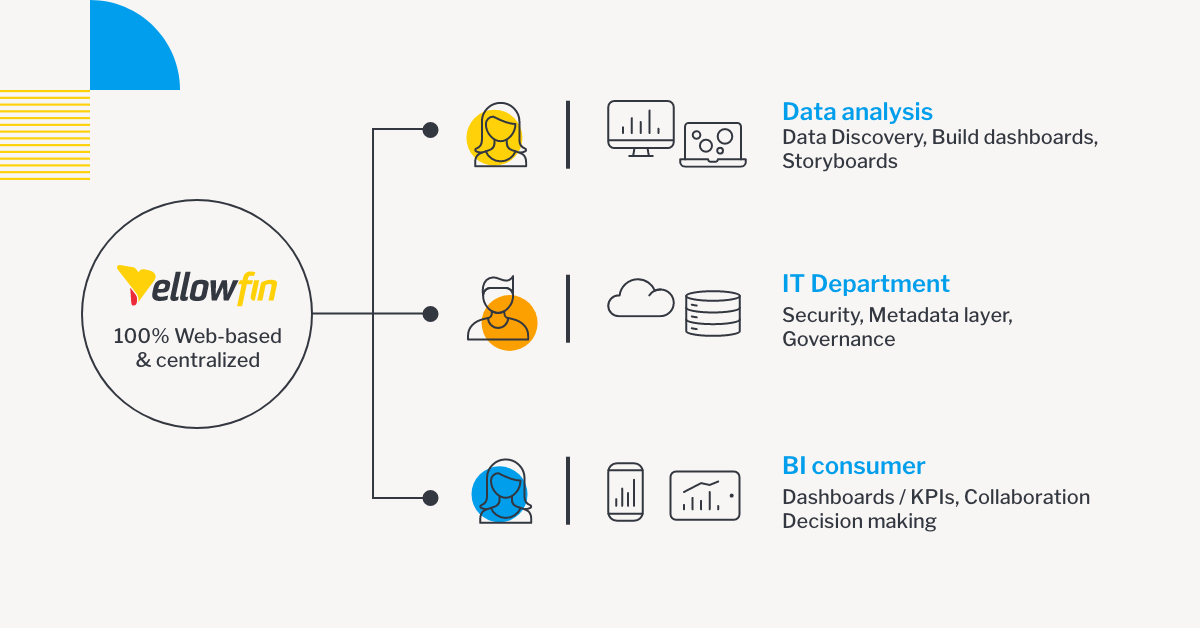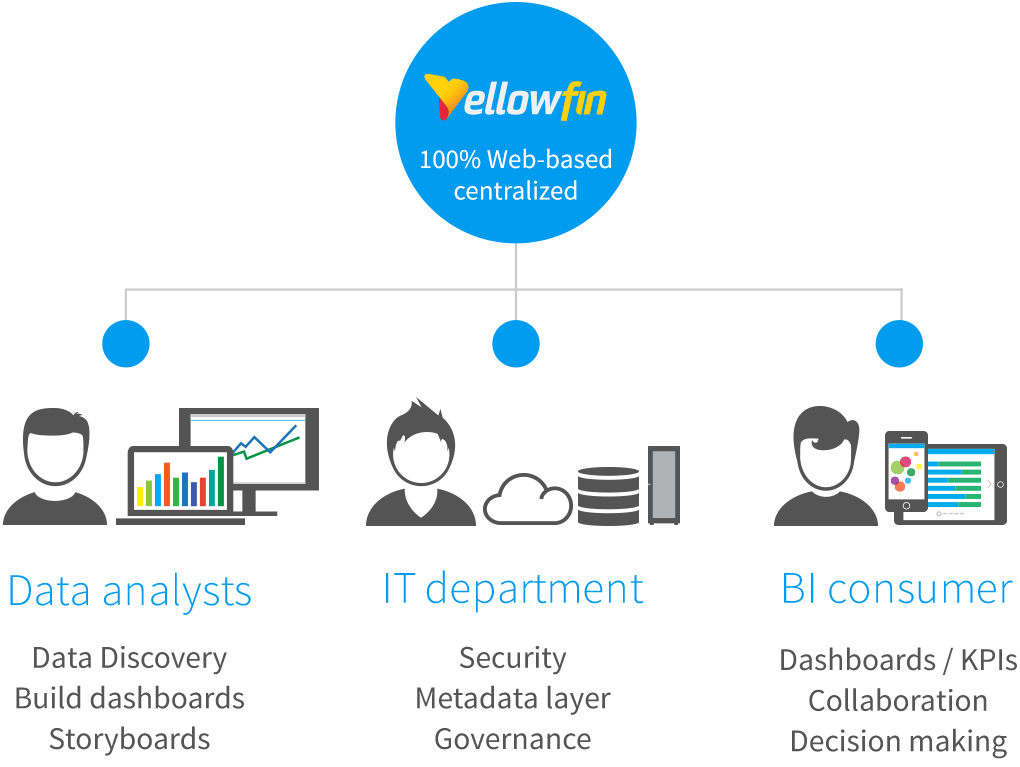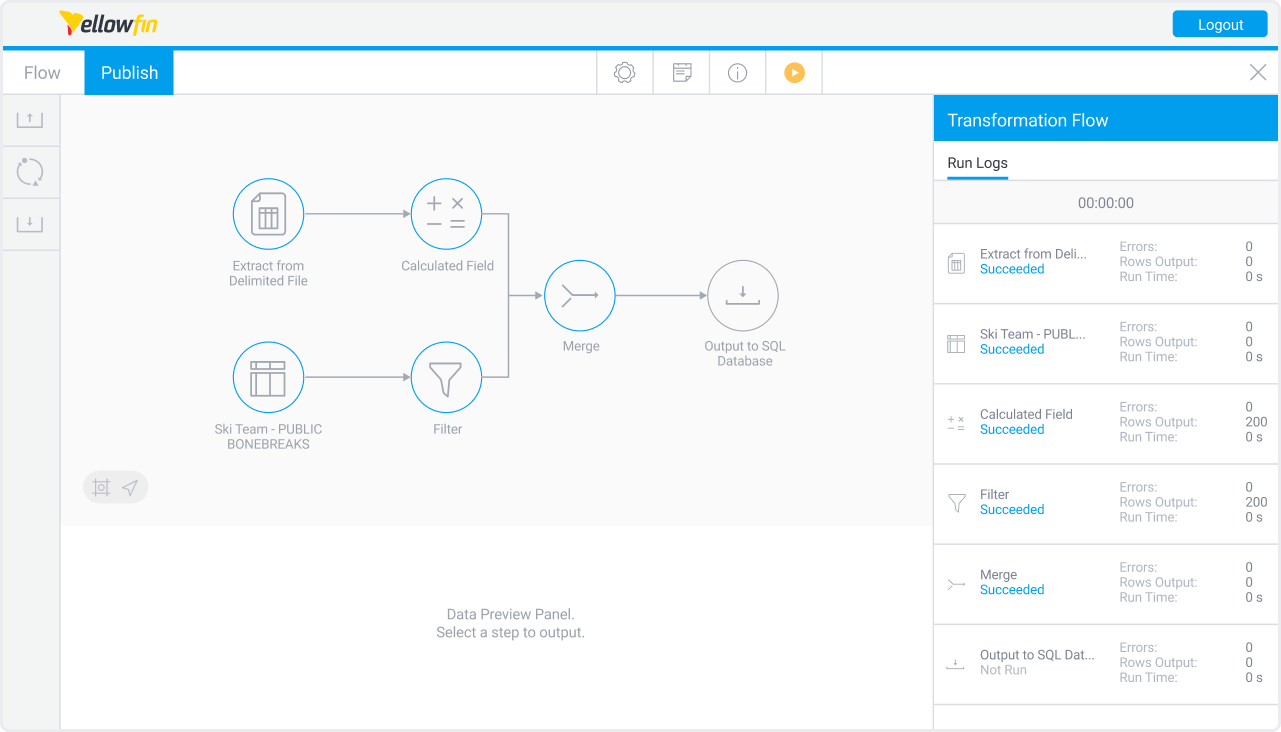
The Business Benefits of Centralized Business Intelligence (BI)
Choosing the right business intelligence (BI) solution is pivotal for independent software vendors (ISVs) and enterprise organizations aiming for data-driven decision-making. But with so many preferences and use cases to account for, certain considerations can, initially, get overlooked.
Centralized business intelligence (BI) is one such topic that requires careful preparation to achieve a nuanced understanding. Having the right control, governance and security over your data management, configurable in one central model, is important, but with so many different systems and requirements out there, you need to assess whether it’s right for your use case.
So, what is centralized business intelligence? This article will break down the concept, and help you get started in understanding whether the model best suits your business, your users, and your goals, and how embedded analytics solutions such as Yellowfin can help.
What is centralized business intelligence (BI)?
Centralized business intelligence refers to a system where data collection, storage, and analysis are managed through a single, unified platform or solution. In this specific setup, all of your data flows into one central repository, allowing for consistent, standardized reporting and analysis.
It’s important to establish that centralized BI refers to both:
- A systematic approach to data control
- A type of feature-set within certain analytics solutions that facilitate centralization
We will go into detail about both distinctions of the term in the following sections.
1. Centralized business intelligence as an approach to data analysis
Centralized BI as an approach to data analysis involves integrating all data sources into a single, cohesive system, which is then used to manage and maintain control over data security, data quality, data compliance and reporting. A central data governance framework is typically established in this model to standardize the policies and procedures your teams follow that help ensure all your data used for analysis is accurate, consistent, and secure. This is particularly important for sectors that need to comply with strict regulatory requirements to minimize risk of data breaches, like financial institutions, government agencies, and healthcare organizations.
The purpose of using a centralized BI framework is to help make data analysis more efficient and comprehensive. By integrating all data sources from various departments, systems and locations, as well as configuration and governance into one system, the aim is to analyze data using the same criteria and methodologies, leading to more reliable and actionable insights.
2. Centralized business intelligence as a product feature
In the context of BI solutions, centralized BI means that the business intelligence solution in question is specifically designed for centralized data management, reporting, and analysis. Yellowfin BI is one example of an embedded analytics solution tailored toward centralized BI.
In these solutions, your analytical processes, from data extraction to report generation, occur within a central interface. This simplifies the user experience by providing a consistent, unified place and set of tools. With a single point of management, your data administrators can also easily control who has access to what data, ensuring that sensitive information is only available to authorized users. This central management of data permissions also enhances data security and data compliance, crucial for any organization handling large volumes of sensitive data.
What are the benefits of centralized business intelligence?
The primary benefit of the centralized business intelligence approach is the elimination of data silos, which ensures that your decision-makers across the organization have access to the same information, fostering a single source of truth.
Furthermore, centralized BI facilitates better data visualization and reporting. By centralizing all your data and analysis tools, your organization can create standardized reports and dashboards that provide a holistic view of the business. These dashboards can still be tailored later to meet the needs of different stakeholders, but are all derived from the same underlying data, ensuring consistency and accuracy in your reporting.
On an end-user level, centralized BI is very useful for everyday dashboards and reporting. For example, Yellowfin BI allows for your dashboards to be configured and customized centrally, eliminating the need for each end-user to create and customize their local dashboards. This not only saves time, but also ensures that all of your end-users are working with the same metrics and data visualizations, leading to more coherent and aligned reporting and decision-making.
For your data managers and admins, having an analytics solution built around a centralized BI model means you can better keep your data source, security configurations, and reporting methodologies as consistent with your company’s preferences and practices as possible. This is particularly important if you need to maintain very strict control over data due to compliance.
Finally, centralized BI also brings higher data security and improved compliance due to reduced data movement and exports, resulting in lower risk, and time and cost savings.
Learn more: What is Data Governance? Accountability and Quality Control in Analytics
What does centralized BI look like in an analytics solution?
As mentioned earlier, Yellowfin is an embedded analytics solution designed for centralized data management, security, compliance, reporting, and governance. Your entire data preparation flow, from control to security to preparation to connection is all configurable in the same interface.
This design differs from other BI and analytics platforms, such as Tableau, who often force the user to conduct these activities within separate versions of the same analytics suite. Yellowfin accommodates a centralized approach to BI through the following features/design considerations:
- Data access control and authorization settings are unified in a single location.
- Metadata and content is secured and automatically reusable with appropriate access controls.
- Yellowfin maintains a live connection to ensure the latest data is always available.
- Dashboards and reports can be centrally configured and customized, eliminating the need for individual user customization.
In comparison, other vendors such as Tableau limit data access control and permission settings in different aspects of their suite, or maintain different functionality depending on the version of the tool (in Tableau’s case, Desktop vs its server software).
You can view more differences in our detailed (and free) Yellowfin vs Tableau comparison guide.
What are the challenges of centralized BI?
One of the challenges of centralizing data is the varying data security models used by different systems. If you implement security measures at the database level, they may differ between databases. Similarly, if applications handle security, each application may have its own approach. Ideally, you want to consolidate data and distribute it to your end-users in a way that is easily managed, regardless of where it's accessed.
Yellowfin's model can be a significant advantage in this scenario. You can implement security at the data view level (called the Data View layer in Yellowfin) - in other words, based on database levels or specified groups, allowing for the integration of different applications with consolidated datasets stored either in your data warehouse (ideally) or quickly within Yellowfin (ideal for prototyping and short-lived datasets). This enables seamless integration of Yellowfin data into other systems, allowing your analysts to extract valuable insights from their workflows easier.
Centralized BI: Next steps
Centralized business intelligence brings value across the organization and can be a significant benefit for your organization depending on your data requirements. By reading this explainer article, you have taken the first steps to determining whether this model is best-fit for your use case.
Try Yellowfin BI today
Discover the many benefits of Yellowfin and see how it can help you implement a centralized BI model for your unique data management needs.

